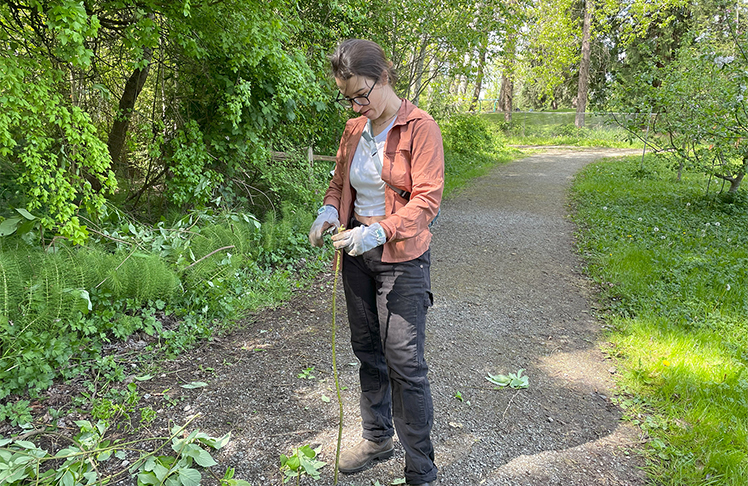
By Cormac Wolf, The Metro Homemaker
Seattle is a city of trees. But those trees aren’t evenly distributed.
Decades of racist zoning and housing practices cast a long shadow in Seattle, sometimes literally. Wealthy white areas like those surrounding Discovery Park and the Arboretum enjoy ample tree cover and shade, while less-affluent neighborhoods are gray with concrete, trapping heat and extending high summer temperatures into the night.
The city has allied with local groups to put forth a multifront approach to the problem, including planting thousands of trees. But those trees won’t lower temperatures for years.
Seattle’s tree planting strategy is rooted in community partnerships. The Trees for Neighborhoods program connects Seattle residents with free trees and training on how to plant and maintain them.
Jana Dilley, head of Trees for Neighborhoods, says her office intends to give 1,300 trees this year to applicants from neighborhoods with less tree cover. Applications open July 1 and close at the end of August. Participants receive up to three free trees, watering and mulch supplies, as well as tailored guidance on planting and permitting.
Though Dilley views trees as integral to long-term heat mitigation, she says they’re not a short-term solution.
“They’re different timelines,” said Dilley. “So we still need to think about things like, you know, access to air conditioning and air conditioned spaces, water, protecting outdoor workers.
“We have to recognize that planting a new tree now is the right thing to do, but it won’t pay off those benefits for a couple decades down the road.”
A 2021 tree canopy report conducted by the City of Seattle found that areas of what the paper calls “disadvantage” (defined as high poverty, poor health and historically racist zoning) in Seattle had nearly a third less tree canopy than more advantaged areas. And that disparity is getting worse. Between 2016 and 2021, the city lost over 255 acres of tree canopy, an area roughly the size of Green Lake, with the loss disproportionately felt in less-affluent neighborhoods like Rainier Beach and Delridge.
A King County heat concentration study conducted the same year showed similarly bleak findings: Seattle’s heat is concentrated in heat islands – areas which absorb, rather than reflect, the heat – predominantly in those same low-income neighborhoods.
With heightened temperature and frequency of heat waves due to climate change, that tree canopy disparity now has a body count.
A report published by the University of Washington’s Climate Impacts Group found that 441 people died during the 2021 heat dome, the most drastic heat event in the region’s history, and which scientists say was made worse and more likely by climate change.
To fight this heat, Washington has turned to trees.
City and county officials cite the county’s 30-year forest plan, which aims at 30% canopy coverage by 2037. But that plan leaves a 10-plus year gap before immature trees have grown enough to provide shade, during which extreme heat will continue to kill.
In addition to connecting individuals with trees for their homes, the city has partnered with dozens of local organizations through the Green Seattle Partnership to safeguard existing green areas. One of those partners, Rainier Beach Urban Farm, hosts volunteer events for locals, especially East African elders, to plant and harvest their own food.
“The farm is parks property and is part of Green Seattle Partnership’s forested land inventory,” said Cameryn Tam, the environmental stewardship specialist at the farm. “Tilth partners with Green Seattle Partnership to help promote community-based restoration in our wetland areas.”
The farm is an example of a shady gathering place integrated into a residential area. But it also showcases the limits of what trees alone can do.
“Our hope,” said Tam, “is to engage Rainier Beach community members in taking the abundance of trees and plants we have onsite right here in the neighborhood and sharing them with other communities.” The farm does not give out trees but invites neighbors to grow fruits and vegetables in the farm’s community plots.
After the 2021 heat survey, the UW Climate Impacts Group (CIG) published another report detailing possible solutions to extreme heat. Jason Vogel, the CIG director, said trees were high on that list, but aren’t a silver bullet.
“For me the problem we’re trying to solve is your people getting sick and dying from heat,” said Vogel. “And then the question is, what role trees have in getting us to that outcome? And recognizing that it’s just one solution and there’s other solutions out there, because people are vulnerable in different ways”
Those other solutions, he said, include artificial shading structures, cooling stations, and water resources called ‘splash pads.’ He also said workers at risk of heat stroke need better enforcement of labor laws limiting working hours.
“So we can make a lot of progress with some tree planting,” Vogel said, “but you know, we have a day like what was going on with the heat dome and 2021 trees are not going to get you all the way to the finish line and keep people safe.”